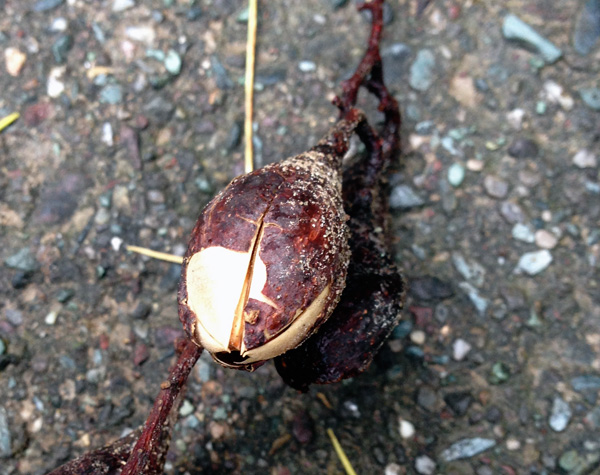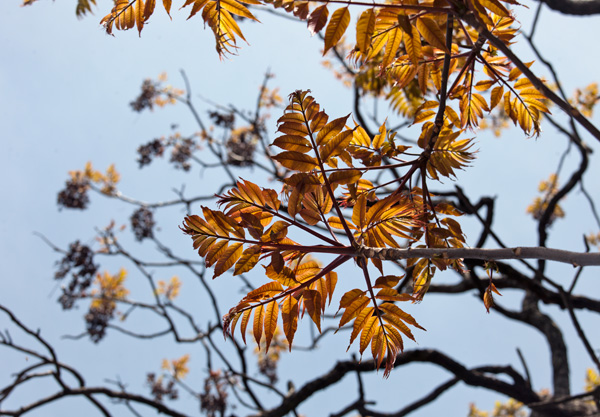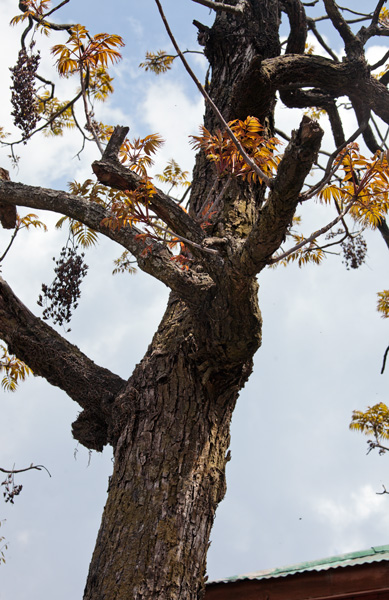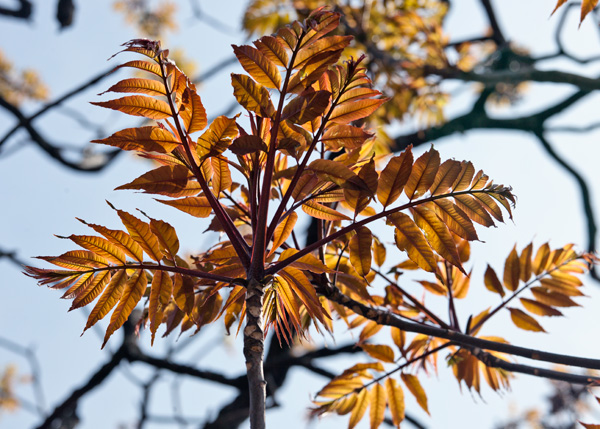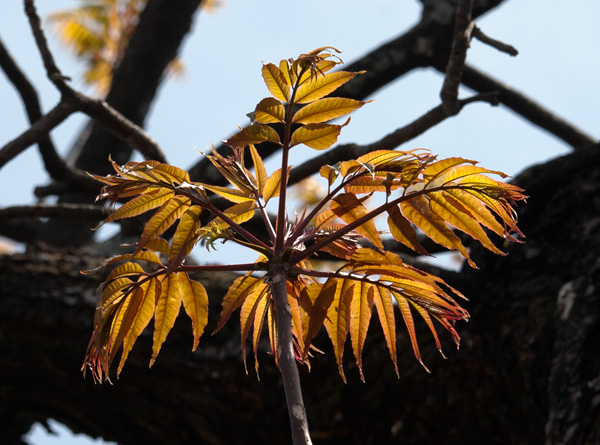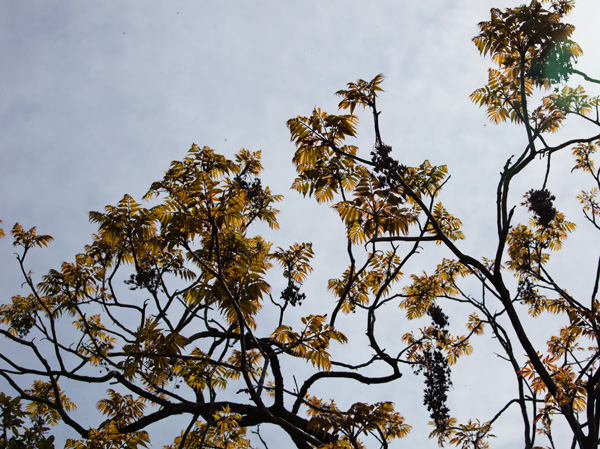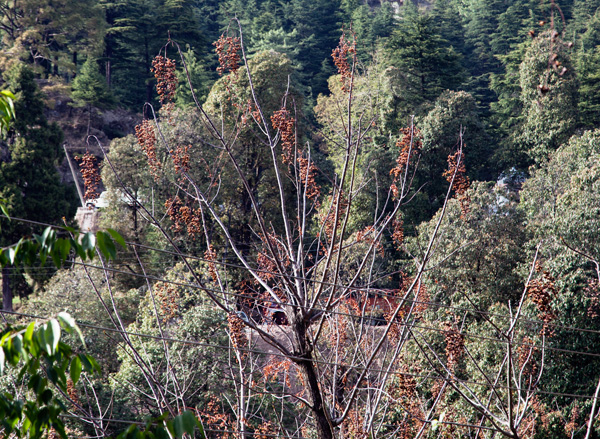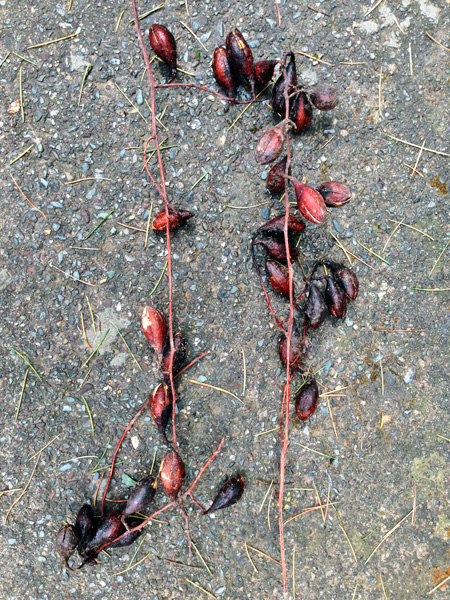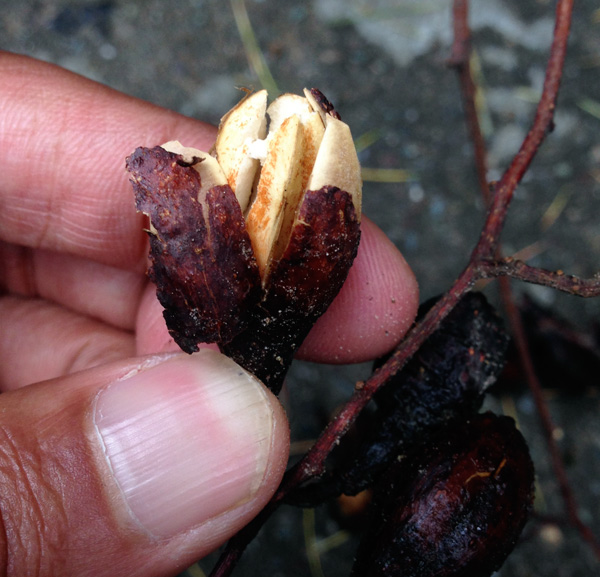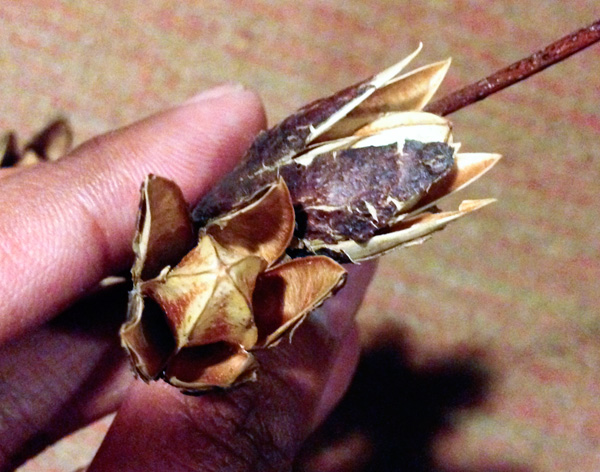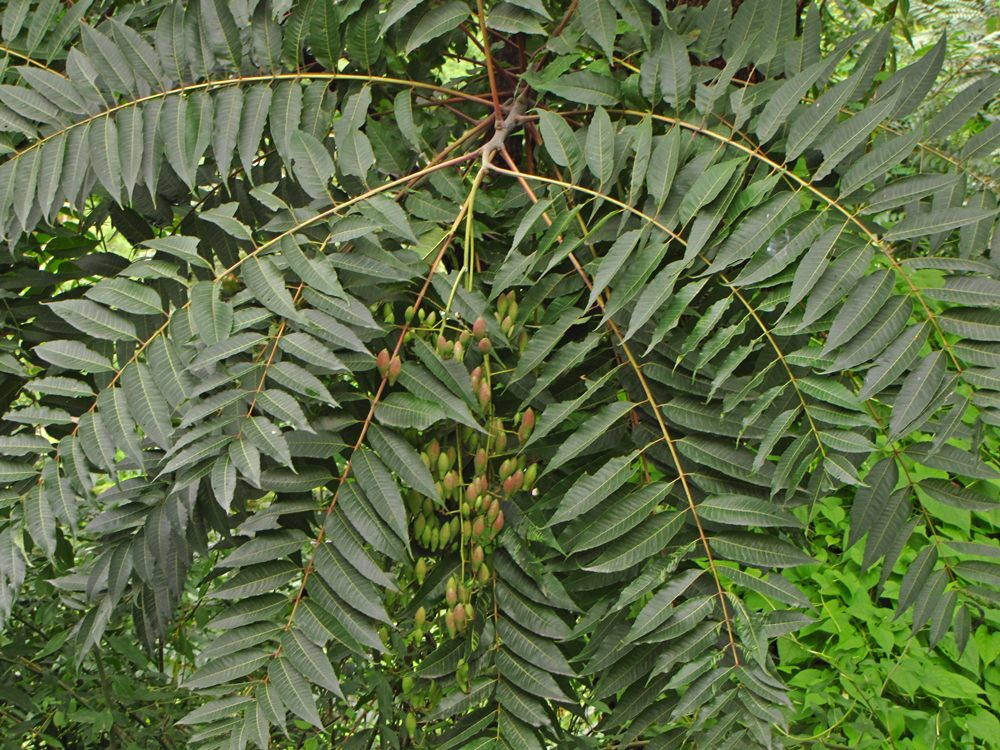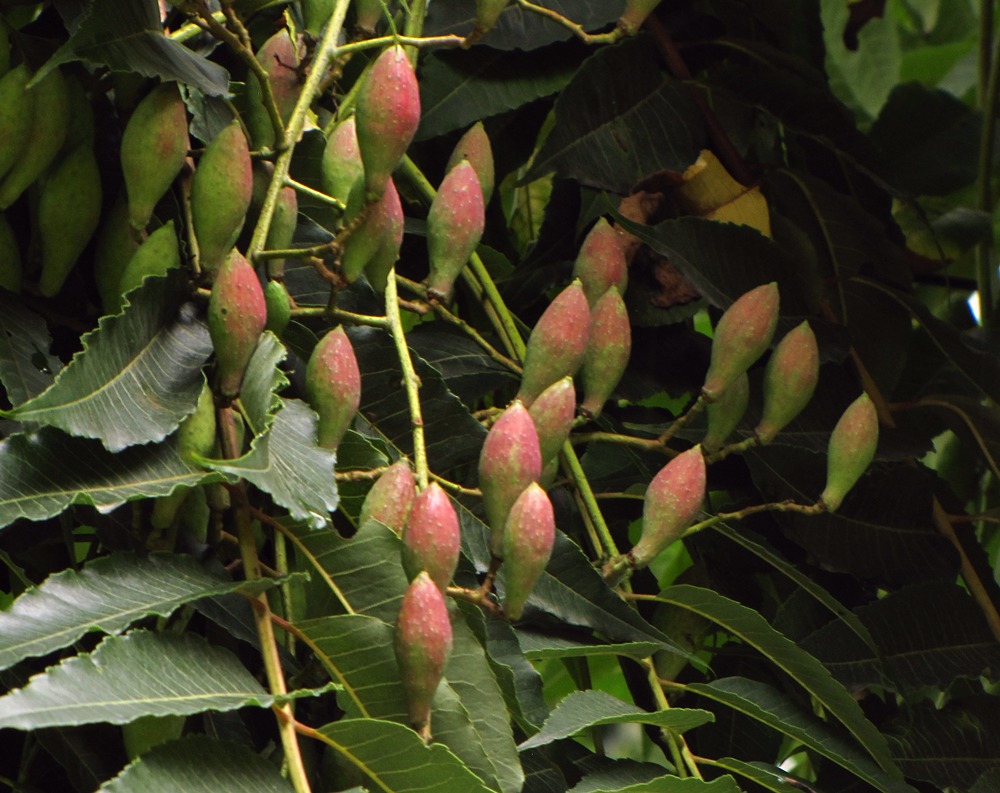|
Toona sinensis (Juss.) M.Roem., Fam. Nat. Syn. Monogr. 1: 139 1846. (Syn: Ailanthus flavescens Carrière; Ailanthus mairei Gagnep.; Cedrela chinensis Franch.; Cedrela glabra C.DC.; Cedrela longiflora var. kumaona C. DC.; Cedrela longifolia Wall. ex C.DC. [Illegitimate] .; Cedrela sinensis Juss. …; Mioptrila odorata Raf.; Surenus glabra (C. DC.) Kuntze; Surenus serrata (Royle) Kuntze; Surenus serrulata (Miq.) Kuntze; Surenus sinensis (Juss.) Kuntze; Toona glabra (C.DC.) Harms; Toona longifolia M.Roem. [Invalid]; Toona microcarpa var. denticulata A. Chev. .; Toona serrata (Royle) M. Roem.; Toona serrulata (Miq.) Harms; Toona sinensis var. hupehana (C. DC.) P.Y. Chen ….);
China (Anhui, Fujian, S-Gansu, Guangdong, Guangxi, Guizhou, Hebei, Henan, Hubei,
Hunan, Jiangsu, Jiangxi, S-Shaanxi, Sichuan, Yunnan, Zhejiang), SE-Tibet, Taiwan (introduced), Ryukyu Isl. (introduced), Korea (introduced), Java, peninsular Malaysia (Perak, Pahang, Selangor), Nepal, Assam, Jammu & Kashmir (Poonch, Kashmir), India (Himachal Pradesh, Uttar Pradesh, Darjeeling, Arunachal Pradesh, Manipur), Sri Lanka (introduced), Thailand, Laos, Vietnam, Sumatra, Borneo, Pakistan (Swat, Hazara, Murree), trop. Africa (introduced), Myanmar [Burma] (Chin, Kachin, Mandalay, Sagaing, Shan), Bhutan as per Catalogue of Life; Common name: Chinese Toon, Chinese Mahogany, Red Toon
Toona sinensis (syn. Cedrela sinensis A.Juss.; Chinese Mahogany, Chinese Toon, or Red Toon (Chinese: 香椿; pinyin: xiāngchūn; Hindi: daaraluu; Malay: suren; Vietnamese: tông dù) is a species of Toona native to eastern and southeastern Asia, from North Korea south through most of eastern, central and southwestern China to Nepal, northeastern India, Myanmar, Thailand, Malaysia, and western Indonesia.[1][2][3][4][5] It is a deciduous tree growing to 25 metres (82 ft) tall with a trunk up to 70 cm diameter. The bark is brown, smooth on young trees, becoming scaly to shaggy on old trees. The leaves are pinnate, 50–70 cm long and 30–40 cm broad, with 10–40 leaflets, the terminal leaflet usually absent (paripinnate) but sometimes present (imparipennate); the individual leaflets 9–15 cm long and 2.5–4 cm broad, with an entire or weakly serrated margin. The flowers are produced in summer in panicles 30–50 cm long at the end of a branch; each flower is small, 4–5 mm diameter, with five white or pale pink petals. The fruit is a capsule 2–3.5 cm long, containing several winged seeds.[1][4][5][6]
The young leaves of T. sinensis (xiāngchūn) are extensively used as a vegetable in China; they have a floral, yet onion-like flavor, attributed to volatile organosulfur compounds.[7] Plants with red young leaves are considered of better flavour than those where the young leaves are green.[1][8][9]
The timber is hard and reddish; it is valuable, used for furniture making [1][6] and for bodies of electric guitars. Being a “true mahogany”, it is the most sought after replacement for Swietenia mahogany (“genuine mahogany”) which is now commercially restricted from being sourced natively.[10]
Outside of its native region T. sinensis is valued more as a large ornamental tree for its haggard aspect.[5][11] It is by far the most cold-tolerant species in the Meliaceae and the only member of the family that can be cultivated successfully in northern Europe.
(From Wikipedia on 18.4.15)
Soymida febrifuga?/ABMAR31 : 9 posts by 4 authors. Attachments (5) Last night we had a lot of rain and I found these twigs on the road. I picked up and photographed them on my phone. There are at least five trees around which are completely bare except for the dried open fruits still hanging in bunches. I did not identify these trees with leaves on them and now will have to wait till they grow back. Judging by the fruit these trees could be Soymida febrifuga or the Indian Redwood Tree (Rohan in Hindi). I am not sure if these are found this high up. Please advise.
Soymida febrifuga
Above Mcleodganj, Dharamshala, HP
1800m approx.
29 March 2015
efi page on Soymida febrifuga
This may be Toona hexandra.
Yes the fruit structure is similar to Cedrela (=Toona) of Meliaceae. It may be Cedrela serrata if seeds are winged on one side only.
Toona species in eFloraofindia (with details/ keys from published papers/ regional floras/ FRLHT/ FOI/ Biotik/ efloras/ books etc., where ever available)
Cedrela serrata Royle is a syn. of Toona sinensis (A. Juss.) M. Roem.
Toona hexandra M.Roem. is also a syn. of Toona ciliata. Pl. see Biodiversity in India, Volume 4 edited by T. Pullaiah (2006) & The Plant List Ver. 1.1
So pl. check the keys & illustrations at Some species found in India with description & keys from Flora of China
Thank you … I also spoke with some locals here who said that the tree was called Duri in the local dialect which translates to the Cedrela serrata but interestingly they also added that it was not Toon. On cutting the star shaped foamy interior of the open fruit, I did not find any seeds, winged or otherwise. A clean cut with scissors is shown in the photo but I also dissected it completely. Please advise.
Seems to be some Toona species.
Please see the link
It may be helpful. However, the fruiting time for C.serrata is mentioned as October in literature. Thank you … I will wait for the leaves to come out and share the additional information. I spoke with another local resident this morning who again swore that it was not Toon but Duri and informed me that the wood from Duri was excellent and repelled insects like that of Cedrus deodara.
The tree has new leaves and it certainly looks a lot like Toona sinensis or Cedrela serrata. Please advise.
Attachments (5)
VoF Week: Toona ciliata ? near Govindghat : 5 posts by 3 authors. Attachments (4) I think this tree is Toona ciliata (Family: Meliaceae)?
Date/Time: 10-08-2012 / 12:00PM Location: Near Govindghat I think Yes. Toona ciliata To me appears close as per images of Toona sinensis at
|
Toona sinensis
Updated on December 24, 2024

